Key takeaways:
- Effective illustration feedback involves balancing personal vision with constructive insights from others.
- Creating a supportive environment encourages open dialogue and helps in receiving criticism positively.
- Analyzing and categorizing feedback aids in identifying common themes and aligning critiques with artistic intentions.
- Implementing feedback through actionable steps fosters growth and enhances artistic skills over time.
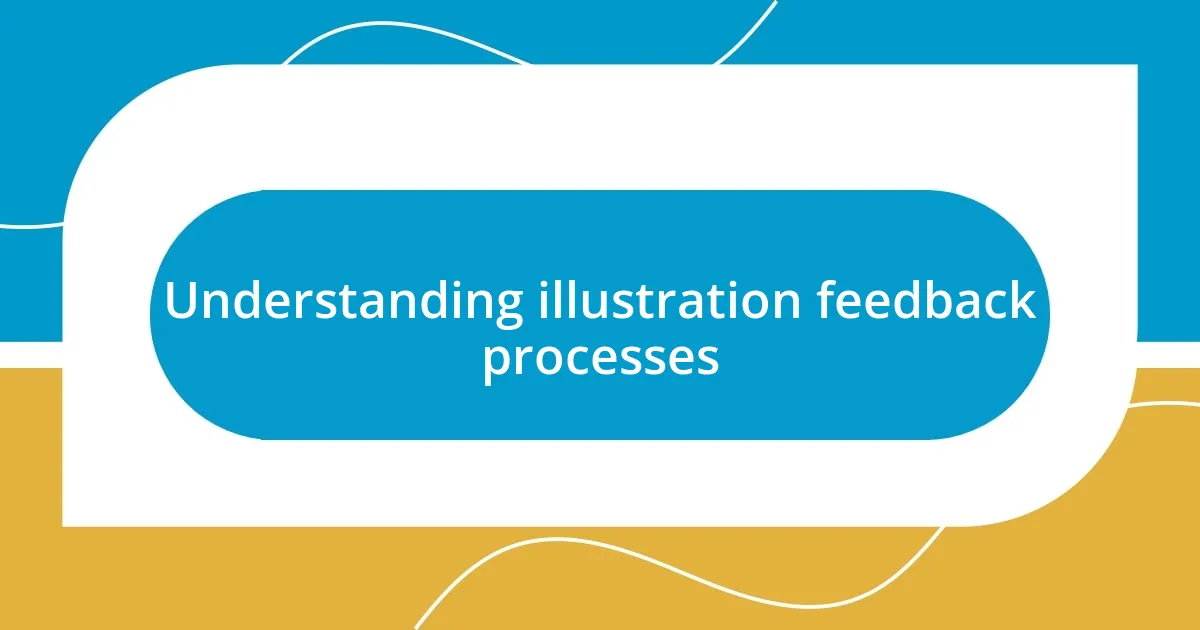
Understanding illustration feedback processes
Understanding illustration feedback processes is crucial for effective communication between artists and their clients. When I first entered the world of illustration, I remember feeling overwhelmed by the range of feedback I received. I often wondered, “How much of this is subjective, and how much is constructive?” Over time, I learned to view feedback not just as critique but as a valuable tool for growth.
One of the key aspects of feedback is knowing when to embrace it and when to trust your instincts. There were moments when well-meaning suggestions led me away from my original vision, leaving me frustrated. Yet, I also recall times when incorporating feedback opened entirely new avenues in my work. It’s a delicate balance, but it’s important to consider feedback within the context of your creative intentions.
Another component of the illustration feedback process is how to ask for and receive feedback. I often found that providing context—like my goals or emotions behind a piece—helped others give more targeted feedback. Reflecting on these experiences, I’ve realized that fostering an environment where dialogue flows freely cultivates a more meaningful and effective feedback experience. What strategies do you employ to ensure feedback serves your creative vision?
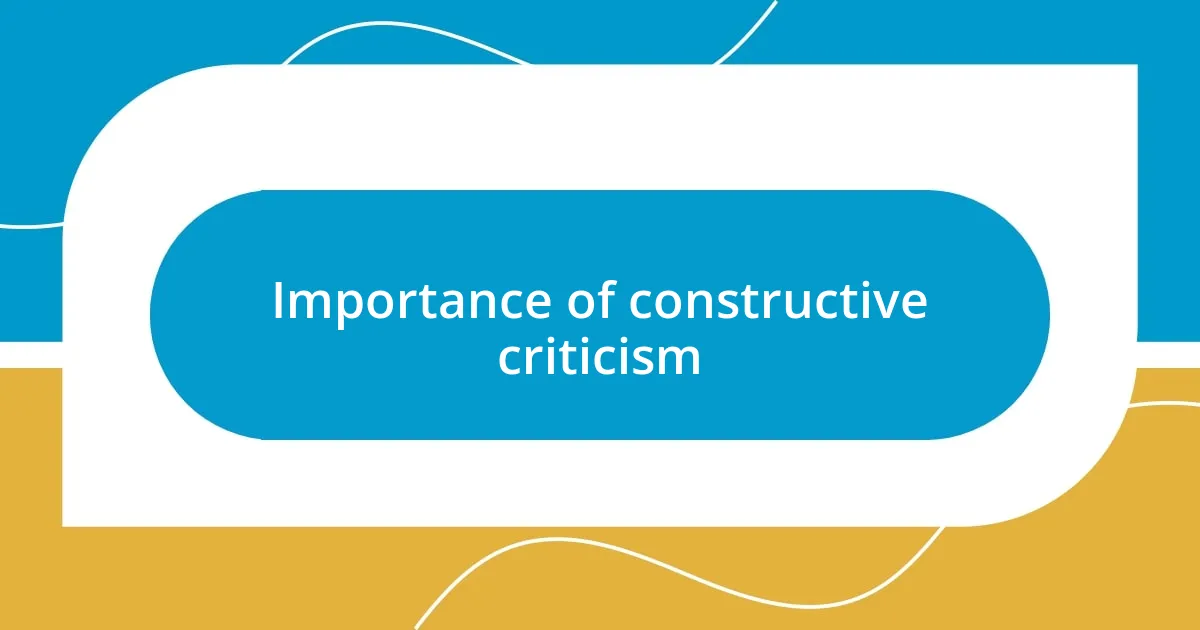
Importance of constructive criticism
Constructive criticism is more than just a series of suggestions; it’s an opportunity for me to reflect on my work and grow as an artist. I vividly recall a time when a mentor pointed out minor inconsistencies in my character designs. At first, I felt defensive, but after some contemplation, I realized those insights vastly improved the overall depth of my illustrations. Embracing those moments redefined my understanding of criticism, showing me that it can be an avenue for improvement and innovation.
The impact of constructive criticism often creates a ripple effect that leads to better artwork and stronger connections with fellow creatives. Once, during a group critique session, I received feedback on a color palette that I had felt passionate about. As I listened to others share their perspectives, I began to understand how a few adjustments could truly enhance the emotional tone of my piece. This revelation reinforced my belief that shared insights often result in a more rounded and compelling final product.
Ultimately, integrating constructive criticism into my workflow has been transformative. It’s not just about receiving feedback but also cultivating a mindset that appreciates the perspectives of others. I cherish the exchanges that lead to breakthroughs, knowing that each thoughtful suggestion brings me closer to the artist I aspire to become. How do you embrace constructive feedback in your practice, and what transformations have you experienced as a result?
| Aspect | Constructive Criticism |
|---|---|
| Purpose | Fosters growth and improvement |
| Emotional Response | Can initially feel daunting but leads to enlightenment |
| Result | Enhanced creative output and stronger artistic connections |
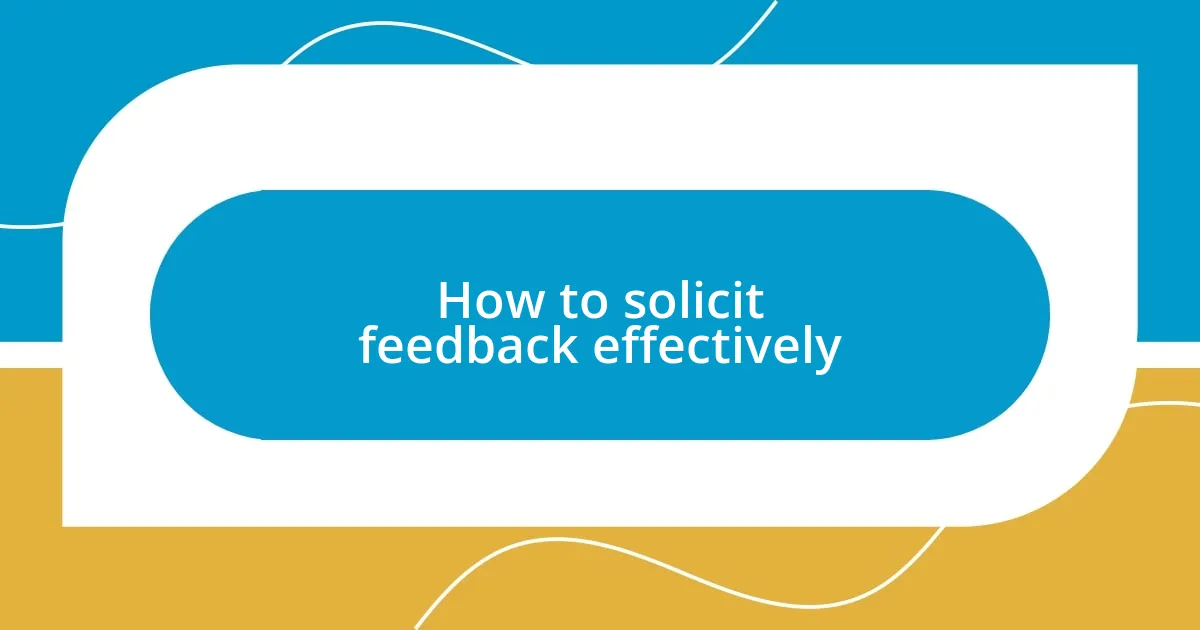
How to solicit feedback effectively
When I want to get insightful feedback, I first make sure to communicate clearly about my work. For instance, I once shared a series of sketches for a project, and instead of asking for general thoughts, I specifically mentioned that I was struggling with the balance between character expression and body language. By narrowing the focus, I received targeted insights that directly addressed my concerns, which was incredibly helpful.
Here are some effective strategies I’ve found useful when soliciting feedback:
- Be specific in your request: Clearly articulate what aspects you want feedback on, such as composition, color, or technique.
- Provide context: Share your motivations, themes, or challenges faced during the creation process to help viewers understand your vision.
- Choose the right audience: Seek input from individuals who have relevant experience or knowledge about your style or subject matter.
- Encourage honest opinions: Let them know you value their genuine feedback and are open to constructive criticism.
- Listen actively: Show that you’re engaged by asking follow-up questions or paraphrasing what they share to reinforce understanding.
I’ve learned that the way I approach a feedback session can greatly influence the quality of the insights I receive. I remember a collaborative meeting where I was apprehensive about sharing my latest piece. Once I opened up about my anxieties regarding its theme, I was met with a flood of understanding and thoughtful critiques that helped me navigate those uncertainties. Creating a space where everyone feels comfortable can transform the feedback experience into something truly enriching.

Creating a feedback-friendly environment
To cultivate a feedback-friendly environment, I believe it’s vital to prioritize openness and trust. I remember a workshop I attended where the facilitator emphasized the importance of establishing ground rules for sharing opinions. This made everyone feel secure, allowing us to speak candidly without fear of judgment. Have you ever been in a situation where the atmosphere felt tense? Creating a foundation of respect allows feedback to flow more freely, transforming anxiety into excitement for improvement.
I’ve also found that actively celebrating each other’s strengths can lighten the mood and create a sense of camaraderie. In one collaborative project, we started our feedback sessions by highlighting what we loved about each other’s work. This positive reinforcement helped ease any initial discomfort about offering critiques. When was the last time you felt appreciated before receiving feedback? By sharing praises, we can ensure that constructive criticism is received in a spirit of growth rather than defensiveness.
Lastly, follow-up is a crucial part of maintaining a feedback-friendly environment. After a critique, I like to check in with my peers to discuss how their feedback influenced my revisions. I vividly recall refining a character design after a group session, only to find that my fellow artists had insightful follow-up comments a few weeks later. This ongoing dialogue not only helps clarify suggestions but also builds a shared sense of investment in each other’s artistic journeys. How often do we create spaces for continued conversations around feedback? Keeping the dialogue open fosters deeper understanding and collaboration.
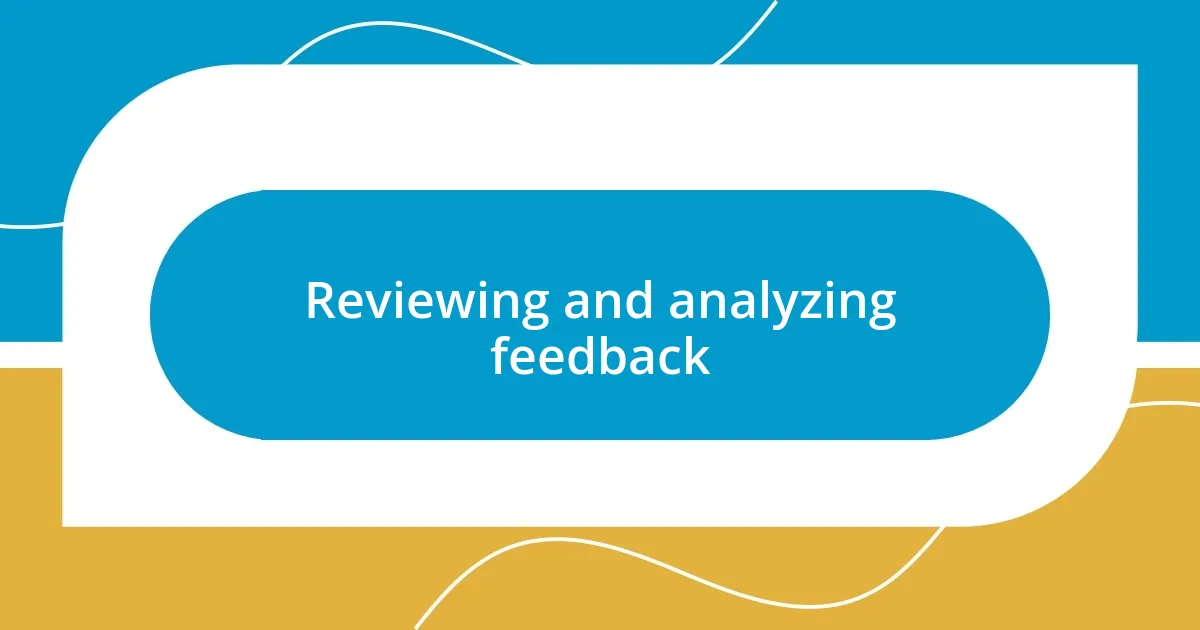
Reviewing and analyzing feedback
When I dive into feedback, I feel it’s essential to sift through the various suggestions and critiques with a discerning eye. I remember receiving feedback on a project that left me feeling overwhelmed at first. There were so many opinions, and it was tough to figure out what resonated most with me. To make sense of it all, I started grouping the comments by theme. This not only organized my thoughts but also highlighted patterns that pointed to bigger issues in my work. Have you ever experienced a similar situation where feedback felt chaotic? By creating some order, I discovered valuable insights that I might have overlooked.
Analyzing feedback isn’t just about understanding what others think; it’s also about reflecting on how it aligns with my artistic vision. I recall a moment when I received mixed reviews about a color choice in my illustration. While some loved its boldness, others felt it was too jarring. Instead of feeling deflated, I sat down and revisited my original intent. This process allowed me to weigh the feedback against my personal style, ultimately helping me craft a more cohesive piece. How often do we stop to reflect on our own vision in the feedback process? It’s a crucial step that can turn insights into thoughtful adjustments rather than just changes based on others’ preferences.
I’ve found it helpful to document feedback and my reactions to it over time. After a recent exhibition, I compiled critiques and insights from attendees in a journal. As I revisited these notes weeks later, I was surprised by how my understanding shifted. What initially felt like harsh critiques transformed into actionable steps that enhanced my skills. I began to see feedback not just as commentary but as part of my growth journey. Have you ever revisited feedback that surprised you in its impact? Recording these moments helps create a tangible roadmap of my artistic evolution that I can refer back to in future projects.

Implementing feedback into your work
When it comes to implementing feedback, I like to turn suggestions into action steps. I remember a mentor once suggested that I narrow my focus on a specific element of my work rather than trying to tackle everything at once. This advice clicked with me—I started creating a checklist based on the feedback, allowing each point to serve as a mini-goal during my revisions. Have you ever felt paralyzed by too much feedback? Breaking down the process made the task feel so much more manageable and less daunting.
I also think it’s vital to be open-minded about the revisions I make. There was a time when a fellow artist pointed out that my character’s emotion wasn’t coming through in an illustration. At first, I felt a bit defensive, but then I took a step back and really considered their perspective. Adjusting facial expressions made a world of difference, bringing the character to life. Have you had that moment when a slight change led to a major improvement? It’s incredible how embracing initial discomfort can lead to unexpected breakthroughs.
Engaging with feedback puts me in a dynamic learning process. I make it a habit to revisit past projects to see how I applied feedback in hindsight. One time, I took a project that felt like a failure at first glance and peeled back the layers of criticism. By reflecting, I realized how those critiques sharpened my skills for subsequent works. How often do we undervalue the lessons learned from our missteps? Each interaction with feedback is a step toward transformation, highlighting the evolution of my artistic journey.
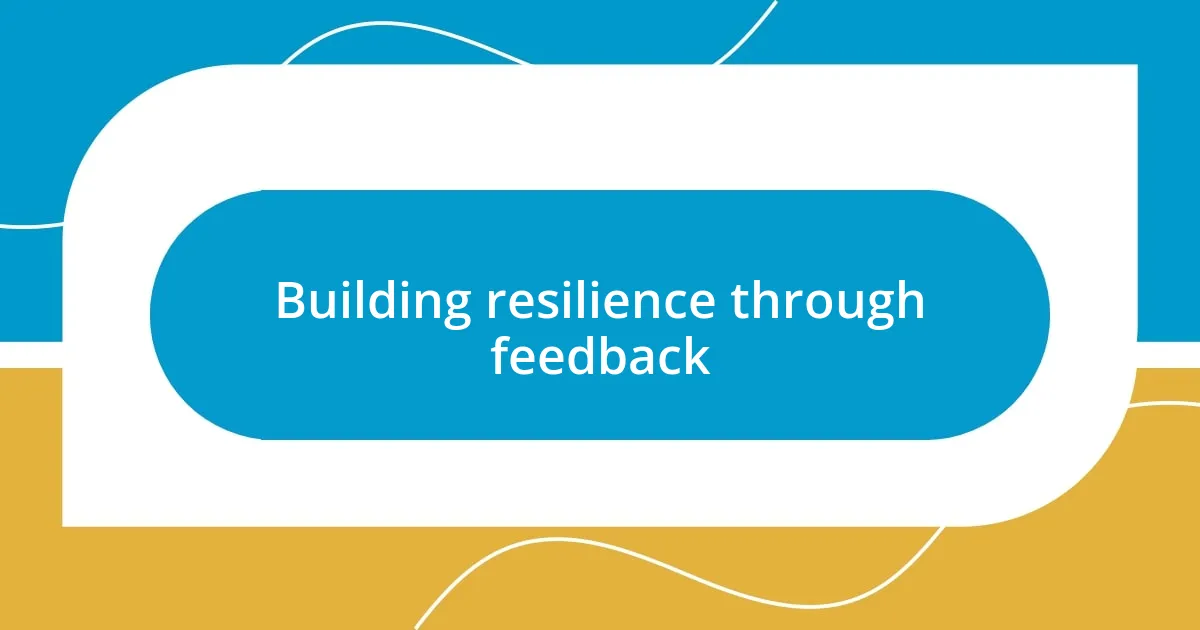
Building resilience through feedback
Sometimes, the toughest feedback really tests your resilience. I remember one project where I poured my heart into an illustration, only to hear from a peer that it lacked depth and emotional punch. At first, it stung, almost sending me into a defensive spiral. Yet, I took a deep breath, stepped back, and realized this feedback was a golden opportunity. Instead of clinging to my initial vision, I re-examined my methods, which ultimately led me to explore new techniques that infused my work with greater emotion. Have you had moments where initial hurt transformed into inspiration?
Feedback also helps me cultivate a growth mindset. A while back, after sharing my work in an online critique group, someone pointed out the awkward proportions in one of my illustrations. My gut reaction was to dismiss it—after all, artistic style is subjective, right? But then I challenged myself to view it as a constructive nudge. I took the time to study various styles and proportions, and the process not only improved that particular piece but also broadened my understanding of anatomy in illustration. Isn’t it fascinating how feedback can stretch our boundaries in unexpected ways?
Embracing feedback often means confronting uncomfortable truths, which is where real growth happens. I vividly recall a critique session that left me feeling exposed when someone suggested I dig deeper into a character’s backstory for a comic I was working on. At first, I felt vulnerable, as if they were questioning my creativity. Yet, as I explored that route, the whole project came alive with richer narratives, making me appreciate the depth of storytelling. Have you ever felt that vulnerability lead to a breakthrough? It’s through those moments of discomfort that I’ve built a stronger foundation as an artist, learning to welcome feedback as a necessary part of my journey.














